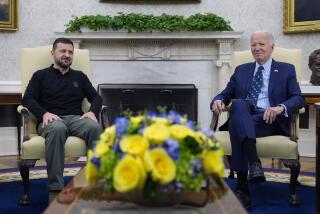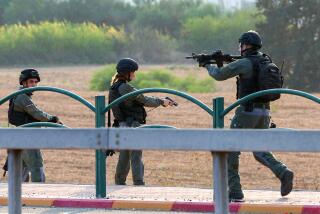Why Did the West Help Arm Iraq? : For the money, of course--but look where that got us
- Share via
When Saddam Hussein moved on Kuwait, he could rely on helicopters from Italy, France, and Germany, rocket launchers from Brazil, artillery pieces and copies of older MiGs from China and Mirage fighters from France. Yugoslavs are working with Iraq on a new rocket that will carry a cluster bomb designed in Chile. And Iraqi combat planes still carry French Exocet missiles of the kind that hit the frigate USS Stark in 1987 and killed 37 American sailors. Iraq also has benefited from the United States: We apparently let computer equipment with military applications slip through. That could wind up killing American boys in the gulf,too.
In truth, though most of Iraq’s weapons came from the Soviet Union--which cut off the flow right after Kuwait was invaded--Western arms deals are amply represented. Now some very nasty chickens representing years of peddling weapons to Saddam Hussein without character references are coming home to roost. There are lessons here for the West.
THE ARMS LIST: Some of the chickens are nastier than others, the nastiest being Iraq’s stockpile of chemical weapons. It has used chemical weapons on its own dissidents in Iraq’s rugged north. It has threatened to use them against Israel and any other country that attacks it. Nobody knows whether that is bluster, just as nobody knows for certain who sold Baghdad the machinery for manufacturing chemical weapons. The factory or factories obviously did not spring from the desert and had to have come from an industrial nation.
Other examples are Soviet MiG-29s, the newest in the MiG line of Soviet fighter planes, although Iraq has only 18 of them, and its 532 other combat planes are older and slower.
Many of its tanks are Soviet hand-me-downs, as are two surface-to-surface missile systems--the FROG 7 and the Scud B. But when you have 5,500 tanks and your most heavily-armed neighbor has 500, it matters less if they are castoffs.
The point is that the industrial world ignored warnings all through the Cold War about the dangers of spreading even obsolescent weapons through the Third World.
THE RATIONALE: Some countries looked at arms sales as cash transactions, scarcely different from any other line of work. The decision in the United States about whether the federal budget could absorb a new fighter-bomber often turned on whether the manufacturer could sell some of them to other air forces. For the Soviets, the sale of arms was most often ideological, designed to increase Soviet prestige when its allies prevailed in regional conflicts.
THE FUTURE: The list of arms sellers is not the full roster of the United Nations, but it still is too long for times like these. If, as many analysts believe, Iraq’s grab for regional power and the oil and gold of Kuwait set the pattern for what industrial nations can expect in the near future, the list must be trimmed to zero. With the threat of global war between the superpowers and their surrogates fading, the European community has been gearing up to enhance its stature as an economic power. But it may well have to stop selling guns in order to buy butter if it expects to live in peace: Free-lancing tyrants can be as disruptive as organized ideological confrontations.
The arms market is lucrative. But a halt in, or even an embargo on, the traffic in arms that could be used by another greedy tyrant to mimic Hussein’s grab of Kuwait is something the big powers must consider. The sales once could be justified by contending that Iraq was armed by an alien superpower ideology. That argument is weaker by the day. It was also argued that if we didn’t arm them then others would. Perhaps, but it’s all the more reason for the West to review its self-defeating policy of arms sales to the Third World.
More to Read
Sign up for Essential California
The most important California stories and recommendations in your inbox every morning.
You may occasionally receive promotional content from the Los Angeles Times.













